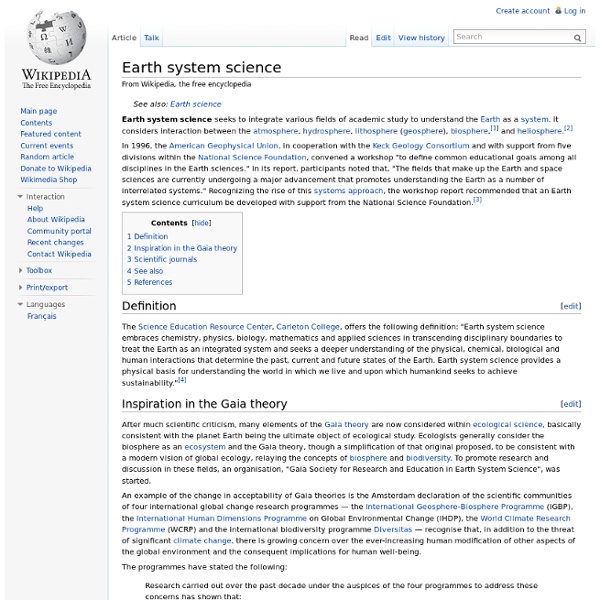Earth spheres Wili
The following outline is provided as an overview of and topical guide to earth science: Earth's spheres[edit] The Earth's spheres are the many "spheres" into which the planet Earth is divided. Branches of earth science[edit] Geology[edit] Geography[edit] Soil science[edit] Atmospheric science[edit] Oceanography[edit] Glaciology[edit] Glaciology Geoinformatics[edit] History of earth science[edit] Main article: History of earth science; see also History of geology Earth science topics[edit] Main article: List of earth science topics See also[edit] List of geoscience organizations References[edit] External links[edit]
Home
Earth System Science
Bézier Curve
Given a set of control points , the corresponding Bézier curve (or Bernstein-Bézier curve) is given by where is a Bernstein polynomial and . A "rational" Bézier curve is defined by is the order, are the Bernstein polynomials, are control points, and the weight of is the last ordinate of the homogeneous point . The Bézier curve always passes through the first and last control points and lies within the convex hull of the control points. and at the endpoints. Undesirable properties of Bézier curves are their numerical instability for large numbers of control points, and the fact that moving a single control point changes the global shape of the curve.
The Savory Institute: Healing the World’s Grasslands, Rangelands and Savannas
9inShare Share This is the first of a two-part interview with Allan Savory, President and Co-Founder of The Savory Institute, an organization based in Zimbabwe that works with farmers, pastoralists, and ranchers to restore degraded lands through holistic management practices. Savory is a winner of the 2010 Buckminster Fuller Challenge, which awards recipients for innovative thinking to solve some of the world’s most pressing problems. Livestock production, particularly cattle, has been blamed in recent years for environmental degradation on both the local and global scales. Do you agree with this perspective? A desert grassland in southern New Mexico, photographed in 1961. Yes, livestock are blamed for environmental degradation, and rightly so. It was for this reason that I, in my days as a young scientist, hated livestock and the people running them. People who are critical of livestock are right to be deeply concerned. Is the third tool, technology, an option? Similar posts:
Bézier curve
The basis functions on the range t in [0,1] for cubic Bézier curves: blue: y0 = (1 − t)3, green: y1 = 3(1 − t)2 t, red: y2 = 3(1 − t) t2, and cyan: y3 = t3. A Bézier curve is a parametric curve frequently used in computer graphics and related fields. Generalizations of Bézier curves to higher dimensions are called Bézier surfaces, of which the Bézier triangle is a special case. In vector graphics, Bézier curves are used to model smooth curves that can be scaled indefinitely. "Paths", as they are commonly referred to in image manipulation programs,[note 1] are combinations of linked Bézier curves. Bézier curves are also used in the time domain, particularly in animation and user interface[note 2] design. The mathematical basis for Bézier curves — the Bernstein polynomial — has been known since 1912, but its applicability to graphics was understood half a century later. Applications[edit] Computer graphics[edit] Quadratic and cubic Bézier curves are most common. Animation[edit] Fonts[edit] Let
grazing chart
A Four Dollar Grazing Chart by Troy Bishopp An image of my grazing chart. Photo by Troy Bishopp My farm teetered between a D1 and D2 (Moderate to severe) on the U. I know what you’re thinking; a piece of paper (and not money) is credited with getting a farmer through the grazing season. On a trip to Missouri visiting Greg Judy’s farm the light really clicked for me. This led me to Allan Savory’s Holistic Management Handbook with associated grazing charts but like many farmers, I had to tweak the chart to fit my needs and environment. Parched grass before the rains. Invaluable in this process is that you need to know what you’re managing towards, know your paddocks and acreages, know your forage and animal needs and know your financial picture. From there I plugged in known forage inventory from all paddocks and what recovery period I wanted to achieve given the heifer’s forage demand. Lush pasture after the rains. Comments Leave a Reply
Large rise in CO2 emissions sounds climate change alarm
Hawaii's Mauna Loa observatory, where record CO2 increases are being documented (Photograph: Richard Vogel/AP) The chances of the world holding temperature rises to 2C – the level of global warming considered "safe" by scientists – appear to be fading fast with US scientists reporting the second-greatest annual rise in CO2 emissions in 2012. Carbon dioxide levels measured at at Mauna Loa observatory in Hawaii jumped by 2.67 parts per million (ppm) in 2012 to 395ppm, said Pieter Tans, who leads the greenhouse gas measurement team for the US National Oceanic and Atmospheric Administration (NOAA). The record was an increase of 2.93ppm in 1998. The jump comes as a study published in Science on Thursday looking at global surface temperatures for the past 1,500 years warned that "recent warming is unprecedented", prompting UN climate chief, Christiana Figueres, to say that "staggering global temps show urgent need to act. "We are in [getting] into new climatic territory.



